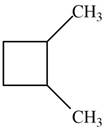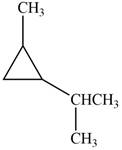
Chemistry for Today: General, Organic, and Biochemistry
9th Edition
ISBN: 9781305960060
Author: Spencer L. Seager, Michael R. Slabaugh, Maren S. Hansen
Publisher: Cengage Learning
expand_more
expand_more
format_list_bulleted
Concept explainers
Textbook Question
Chapter 11, Problem 11.52E
Which of the following cycloalkanes could show geometric isomerism? For each that could, draw structural formulas, and name both the cis- and the trans- isomers.
a.  c.
c. 
b.  d.
d. 
Expert Solution & Answer
Trending nowThis is a popular solution!

Students have asked these similar questions
solve please
Please answer the question and provide a detailed drawing of the structure. If there will not be a new C – C bond, then the box under the drawing area will be checked.
Will the following reaction make a molecule with a new C – C bond as its major product:
Draw the major organic product or products, if the reaction will work. Be sure you use wedge and dash bonds if necessary, for example to distinguish between major products with different stereochemistry.
Please do not use AI. AI cannot "see" the molecules properly, and it therefore gives the wrong answer while giving incorrect descriptions of the visual images we're looking at. All of these compounds would be produced (I think). In my book, I don't see any rules about yield in this case, like explaining that one product would be present in less yield for this reason or that reason. Please explain why some of these produce less yield than others.
Chapter 11 Solutions
Chemistry for Today: General, Organic, and Biochemistry
Ch. 11 - Prob. 11.1ECh. 11 - Prob. 11.2ECh. 11 - Prob. 11.3ECh. 11 - Prob. 11.4ECh. 11 - Prob. 11.5ECh. 11 - Prob. 11.6ECh. 11 - Prob. 11.7ECh. 11 - Prob. 11.8ECh. 11 - Prob. 11.9ECh. 11 - Prob. 11.10E
Ch. 11 - Prob. 11.11ECh. 11 - Prob. 11.12ECh. 11 - Prob. 11.13ECh. 11 - Prob. 11.14ECh. 11 - What molecular geometry exists when a central...Ch. 11 - Compare the shapes of unhybridized p and...Ch. 11 - Use Example 11.1 and Tables 11.2 and 11.6 to...Ch. 11 - Prob. 11.18ECh. 11 - Prob. 11.19ECh. 11 - Prob. 11.20ECh. 11 - Prob. 11.21ECh. 11 - Prob. 11.22ECh. 11 - Prob. 11.23ECh. 11 - Write a condensed structural formula for the...Ch. 11 - Write a condensed structural formula for the...Ch. 11 - Write an expanded structural formula for the...Ch. 11 - Prob. 11.27ECh. 11 - Classify each of the following compounds as a...Ch. 11 - Why are different conformations of an alkane not...Ch. 11 - Which of the following pairs represent structural...Ch. 11 - Prob. 11.31ECh. 11 - Prob. 11.32ECh. 11 - Identify the following alkyl groups: a. b....Ch. 11 - Prob. 11.34ECh. 11 - Prob. 11.35ECh. 11 - Draw a condensed structural formula for each of...Ch. 11 - Prob. 11.37ECh. 11 - Prob. 11.38ECh. 11 - Prob. 11.39ECh. 11 - Prob. 11.40ECh. 11 - The following names are incorrect, according to...Ch. 11 - The following names are incorrect, according to...Ch. 11 - Prob. 11.43ECh. 11 - Write the correct IUPAC name for each of the...Ch. 11 - Write the correct IUPAC name for each of the...Ch. 11 - Draw the structural formulas corresponding to each...Ch. 11 - Prob. 11.47ECh. 11 - Which of the following pairs of cycloalkanes...Ch. 11 - Prob. 11.49ECh. 11 - Prob. 11.50ECh. 11 - Prob. 11.51ECh. 11 - Which of the following cycloalkanes could show...Ch. 11 - Prob. 11.53ECh. 11 - Using the prefix cis- or trans-, name each of the...Ch. 11 - Prob. 11.55ECh. 11 - The compound decane is a straight-chain alkane....Ch. 11 - Explain why alkanes of low molecular weight have...Ch. 11 - Suppose you have a sample of 2-methylhexane and a...Ch. 11 - Identify circle the alkanelike portions of the...Ch. 11 - Prob. 11.60ECh. 11 - Prob. 11.61ECh. 11 - Write a balanced equation for the incomplete...Ch. 11 - Prob. 11.63ECh. 11 - Prob. 11.64ECh. 11 - Prob. 11.65ECh. 11 - Prob. 11.66ECh. 11 - Prob. 11.67ECh. 11 - Prob. 11.68ECh. 11 - Would you expect a molecule of urea produced in...Ch. 11 - Prob. 11.70ECh. 11 - Prob. 11.71ECh. 11 - Prob. 11.72ECh. 11 - Prob. 11.73ECh. 11 - Prob. 11.74ECh. 11 - Prob. 11.75ECh. 11 - A semi-truck loaded with cyclohexane overturns...Ch. 11 - Prob. 11.77ECh. 11 - Oil spills along coastal shores can be disastrous...Ch. 11 - Prob. 11.79ECh. 11 - Prob. 11.80ECh. 11 - Use the generic formula for alkanes (CnH2n+2) to...Ch. 11 - Prob. 11.82ECh. 11 - Which of the following is an example of an alkane?...Ch. 11 - Prob. 11.84ECh. 11 - Prob. 11.85ECh. 11 - Prob. 11.86ECh. 11 - The deadly property of carbon monoxide, if...
Knowledge Booster
Learn more about
Need a deep-dive on the concept behind this application? Look no further. Learn more about this topic, chemistry and related others by exploring similar questions and additional content below.Similar questions
- Please answer the question and provide detailed explanations.arrow_forwardAll of these compounds would be produced (I think). In my book, I don't see any rules about yield in this case, like explaining that one product would be present in less yield for this reason or that reason. Please explain why some of these produce less yield than others.arrow_forward5. Fill in the missing molecules in the following reaction pathway. TMSO Heat + CI then HF O₂N (1.0 equiv) AICI 3 OMearrow_forward
- e. O₂N NO2 1. excess H2, Pd/C 2. excess NaNO2, HCI 3. excess CuCNarrow_forwardHelp with a periodic table task.' Procedure Part 1: Customizing a Periodic Table Use a textbook or other valid source to determine which elements are metals, nonmetals, metalloids (called semimetals in some texts), alkali metals, alkaline earth metals, transition metals, halogens, and noble gases. Download and print a copy of the Periodic Table of Elements. Use colored pencils, colorful highlighters, or computer drawing tools to devise a schematic for designating each of the following on the periodic table: Group numbers Period number Labels for these groups: alkali metals, alkaline earth metals, transition metals, inner transition metals (lanthanides and actinides), other metals, metalloids (semimetals), other nonmetals, halogens, and noble gases Metals, nonmetals, and metalloids Note: Write the group and period numbers and color/highlight each element for categorization. Be sure to include a key for the schematic. Take a photo of the completed periodic table and upload the…arrow_forwardDon't used hand raiting and don't used Ai solutionarrow_forward
- Can you explain these two problems for mearrow_forward个 ^ Blackboard x Organic Chemistry II Lecture (m x Aktiv Learning App x → C app.aktiv.com ← Curved arrows are used to illustrate the flow of electrons. Using the provided starting and product structures, draw the curved electron-pushing arrows for the following reaction or mechanistic step(s). Be sure to account for all bond-breaking and bond-making steps. Problem 28 of 35 :OH H HH KO Select to Edit Arrows CH CH₂OK, CH CH2OH 5+ H :0: Donearrow_forwardCan you explain those two problems for me please.arrow_forward
- Do we need to draw the "ethyne" first for this problem? im confusedarrow_forwardCan you explain how this problem was solved.arrow_forwardQuestion 2 show work. don't Compound give Ai generated solution So (J K-1 mol-1) A 26 B 54 C 39 D 49 At 298 K, AG° is 375 kJ for the reaction 1A + 1B → 4C + 2D Calculate AH° for this reaction in kJ.arrow_forward
arrow_back_ios
SEE MORE QUESTIONS
arrow_forward_ios
Recommended textbooks for you
 Chemistry for Today: General, Organic, and Bioche...ChemistryISBN:9781305960060Author:Spencer L. Seager, Michael R. Slabaugh, Maren S. HansenPublisher:Cengage Learning
Chemistry for Today: General, Organic, and Bioche...ChemistryISBN:9781305960060Author:Spencer L. Seager, Michael R. Slabaugh, Maren S. HansenPublisher:Cengage Learning Introductory Chemistry: An Active Learning Approa...ChemistryISBN:9781305079250Author:Mark S. Cracolice, Ed PetersPublisher:Cengage Learning
Introductory Chemistry: An Active Learning Approa...ChemistryISBN:9781305079250Author:Mark S. Cracolice, Ed PetersPublisher:Cengage Learning ChemistryChemistryISBN:9781305957404Author:Steven S. Zumdahl, Susan A. Zumdahl, Donald J. DeCostePublisher:Cengage Learning
ChemistryChemistryISBN:9781305957404Author:Steven S. Zumdahl, Susan A. Zumdahl, Donald J. DeCostePublisher:Cengage Learning Chemistry: An Atoms First ApproachChemistryISBN:9781305079243Author:Steven S. Zumdahl, Susan A. ZumdahlPublisher:Cengage Learning
Chemistry: An Atoms First ApproachChemistryISBN:9781305079243Author:Steven S. Zumdahl, Susan A. ZumdahlPublisher:Cengage Learning

Chemistry for Today: General, Organic, and Bioche...
Chemistry
ISBN:9781305960060
Author:Spencer L. Seager, Michael R. Slabaugh, Maren S. Hansen
Publisher:Cengage Learning


Introductory Chemistry: An Active Learning Approa...
Chemistry
ISBN:9781305079250
Author:Mark S. Cracolice, Ed Peters
Publisher:Cengage Learning

Chemistry
Chemistry
ISBN:9781305957404
Author:Steven S. Zumdahl, Susan A. Zumdahl, Donald J. DeCoste
Publisher:Cengage Learning

Chemistry: An Atoms First Approach
Chemistry
ISBN:9781305079243
Author:Steven S. Zumdahl, Susan A. Zumdahl
Publisher:Cengage Learning

Chapter 4 Alkanes and Cycloalkanes Lesson 2; Author: Linda Hanson;https://www.youtube.com/watch?v=AL_CM_Btef4;License: Standard YouTube License, CC-BY
Chapter 4 Alkanes and Cycloalkanes Lesson 1; Author: Linda Hanson;https://www.youtube.com/watch?v=PPIa6EHJMJw;License: Standard Youtube License